April Birthstone: A Complete Guide + 4 Alternative Stones
Those born in April may be luckiest of all. Why? Because the traditional April birthstone is the iconic diamond, the most well-known gemstone in the world.
The month of April is probably named from the Latin aperire, meaning “to open,” because plants like flowers began opening. Ancients associated the month with Aphrodite (or Venus), the goddess of love, fertility, and marriage.
It’s definitely fitting then for April to be represented by the precious gemstone diamond, the stone of love, strength, and eternal beauty.
Want to learn more about the April birthstone? Come along as we break down diamond history, uses, value, and jewelry. We’ll also go over some popular April birthstone alternatives!

Historical & Cultural Significance of April Birthstone: Diamond
Diamonds are illustrious gemstones that not only commemorate April birthdays, but also the 10th, 60th, and 75th wedding anniversaries.
This April birthstone’s color varies from classic white to virtually any color. Those born under Aries (March 21 to April 19) may love a fiery red diamond, while those born under Taurus (April 20 to May 20) might enjoy a soft blue or even chocolate diamond.
But how did diamond become the legendary Queen of Gems it is today?
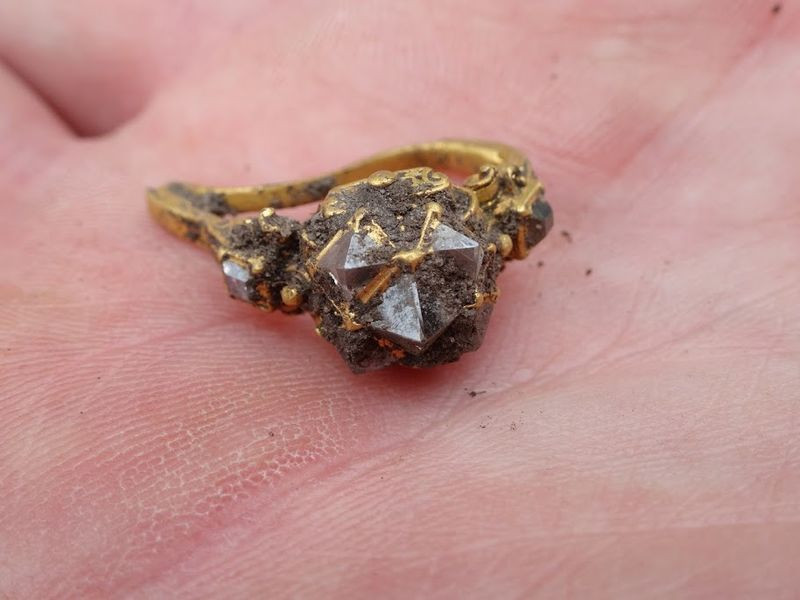 Pictured above: Gold ring with 7 cut diamonds found in Tåsinge. It weighs 7 grams and can be dated to the first half of the 17th century (translated from Danish) | Image credit: Nationalmuseet, CC-BY-SA-3.0
Pictured above: Gold ring with 7 cut diamonds found in Tåsinge. It weighs 7 grams and can be dated to the first half of the 17th century (translated from Danish) | Image credit: Nationalmuseet, CC-BY-SA-3.0
Ancient Diamond History & Folklore
The earliest known diamonds were mined in ancient India, the only source for centuries. Ancient wealthy Indians, lacking banks, used diamonds as investment currency to store away, like gold today.
The science of testing gem quality now called “gemology” was established in India as Ratna Pariksha or Ratnaparīkṣā, meaning “the examination of gems.”
Many ancients had myths and meanings tied to diamonds:
Ancient India: Hindus believed diamonds originated when lightning struck rocks and would attract lightning. The popular Hindu god Krishna was said to have given his lover Radhato a diamond (believed to be the Koh-i-Noor diamond) that reflected her beauty. Indians also believed diamonds provided their wearer invincibility.
Egyptians: Diamonds symbolized bravery, power, and the sun. Pharaohs put diamonds in the center of the ankh, the hieroglyph for “life.”
Romans: Roman legends surrounding diamond’s origin claimed they were gods’ tears or pieces of falling stars. The Roman god Cupid’s arrows supposedly ended in diamonds.
Greeks: One Greek myth goes that Cronos turned a man with intense strength and luck named Adamas — the same as diamond’s etymological root, adamante, meaning “invincible” — into diamond. Greek philosopher Plato described diamonds as the embodiment of celestial beings.
Many societies had similar interpretations of the April birthstone’s meaning: invincibility, love, and divine strength.
As healing stones, some ancients believed diamonds cured poisoning. Folks in Medieval times extended beliefs about diamond’s healing properties to treating everything from heart conditions to depression.
Some opposite beliefs about diamonds being poisonous or cursed spread later, like the infamous legend about the Hope Diamond causing the Titanic to sink.
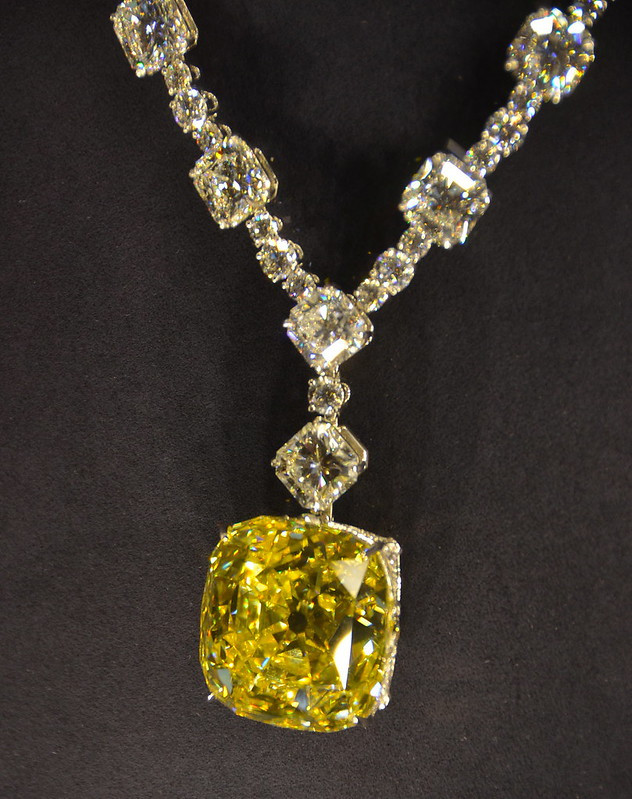 Pictured above: The "Tiffany Diamond," once worn by Audrey Hepburn while promoting Breakfast at Tiffany's | Image credit: Adam Fagen on Flickr, CC-BY-SA-2.0
Pictured above: The "Tiffany Diamond," once worn by Audrey Hepburn while promoting Breakfast at Tiffany's | Image credit: Adam Fagen on Flickr, CC-BY-SA-2.0
Diamonds in Modern Culture & Society
Europe entered the diamond market in the Middle Ages, but only the wealthy and noble wore the April birthstone. Brazil became the main diamond source in the 1700s, and by the 1800s, diamonds became more widely available.
The modern idea of diamonds being extremely rare and elite may partly come from royal connections like the Hope Diamond or Cullinan Diamond. But the true reason stems from an 1870 marketing campaign collaboration by the De Beers Group and N.W. Ayers.
This campaign brought the famous slogan “A Diamond is Forever,” and the idea that engagement rings must have diamonds. In the 1940s, roughly 10 percent of engagement rings had diamonds, while around 87 percent of engagement rings have this April birthstone today.
Modern media also uses diamonds, such as:
“Diamonds Are a Girl’s Best Friend” sung by Marilyn Monroe in Gentlemen Prefer Blondes
“Heart of the Ocean,” the fictional blue diamond necklace in James Cameron’s Titanic
Diamonds are Forever, the 1956 James Bond novel and 1971 film adaptation
Audrey Hepburn’s Tiffany Diamond, worn during promotion for Breakfast at Tiffany’s
“Lucy in the Sky with Diamonds” by the Beatles
… and that’s just the tip of the iceberg!
References aside, what do diamond April birthstones symbolize?
April Birthstone Meaning and Symbolism
The April birthstone diamond is commonly associated with strength, love, protection and prosperity, making it a great gift for loved ones. Below, we go into the April birthstone meanings and symbolism in more detail.
Strength
April birthstones are a symbol of strength, clarity, and vigor. That’s because they are the hardest gemstone and element in nature. They are made of pure carbon, and the layers within the lattice structure make it extremely hard. Contrasting, this durability is the birthstone’s symbol of purity, faith, and everlasting love.
Love
It’s the interplay of gentleness supported by eternal strength that makes diamonds the perfect symbol of marriage. And that’s not all, as the April birthstone, diamonds have powerful healing properties that promote happiness, longevity, and protection.
Protection
In poetic folklore, the April birthstone represents a protective amulet against evil, sickness, death, and the plague.
Prosperity
Diamonds aren’t only forever, they are the “stone of immortality,” and thought to amplify financial fortune and prosperity. It’s the toughness of these stones that makes them suitable for April birthstone jewelry. You can’t wear every gemstone every day, but you can certainly wear a diamond every day because they are so durable.
The diamond’s durability starts with its unique formation.
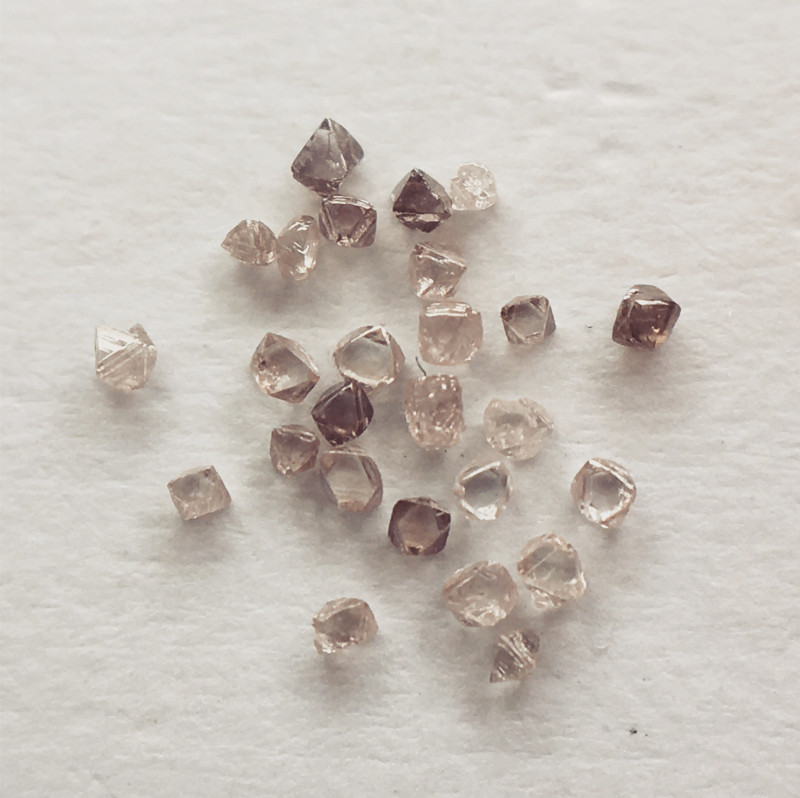
Geological Marvel: The Formation of Diamonds
Diamonds form deep within the Earth, around 100 miles underground. Extremely high pressure and temperatures cause carbon atoms to bond into strong, stiff, consistent patterns over billions of years. Then, volcanic activity brings the gems to the surface.
These April birthstones are just composed of carbon, but their particular arrangement of carbon atom bonds makes them the hardest mineral at 10 on the Mohs scale.
Russia and Botswana are the top producers of gem-quality diamonds currently.
Gem-quality white diamonds range from Type Ia, containing up to 0.3 percent nitrogen, to Type IIb, containing boron and virtually no nitrogen.
These classifications are part of how the April birthstones are graded.
The 4 Cs: Understanding Diamond Quality
Diamonds are often certified by a licensed laboratory like the GIA to grade and verify their quality objectively. Having gemstones certified helps with appraisal, insurance, and confidence in a seller’s claims. You can also get your diamond certified for reselling purposes.
Grading the April birthstone involves looking at the four Cs: color, cut, clarity, and carat weight. Our article on the four Cs of diamond quality has more info, but here’s a quick breakdown:
Color
Highest value goes to fully colorless diamonds, or D on the GIA color scale. The lowest point on the scale is Z for pale yellow or brown.
For naturally colored diamonds, value is tied to rarity. The rarest are red; the most common are yellow or brown. Argyle pink diamonds, along with purple, orange, blue, and green diamonds are also rare.
Cut
Faceted diamond cuts are important for maximizing brilliance (white light), fire (colored light), and scintillation (overall sparkle).
Certain cuts can highlight different qualities, but the cut with the most sparkle is also the most popular: the round brilliant.
Cut grades range from Excellent to Poor, with only 0.1 percent being Excellent.
 Pictured above: Round brilliant cut white diamond earrings
Pictured above: Round brilliant cut white diamond earrings
Clarity
Clarity, the degree of visible inclusions and external blemishes, has two grading scales. Fewer inclusions and blemishes means higher value.
The GIA scale has 11 grades, from Flawless or IF (Internally Flawless, no flaws) to I3 (Included, easily visible inclusions to the naked eye). The AGS (American Gem Society) scale is numerical from 0-10, with 0 corresponding to Internally Flawless and 10 corresponding to I3.
The most common clarity in these April birthstones are SI (Slightly Included), VS (Very Slightly Included or VVS (Very, Very Slightly Included).
Carat Weight
Diamonds are weighed in carats – 1 carat = 0.2 grams. Price-per-carat changes with both quality and size. Two diamonds of equal quality can differ in price-per-carat by over twice as much if one is 1 carat and the other is 2 carats.
In the US, most engagement rings have a 1-carat diamond.
One “grade” outside of gemology is the “industrial-grade” diamond.
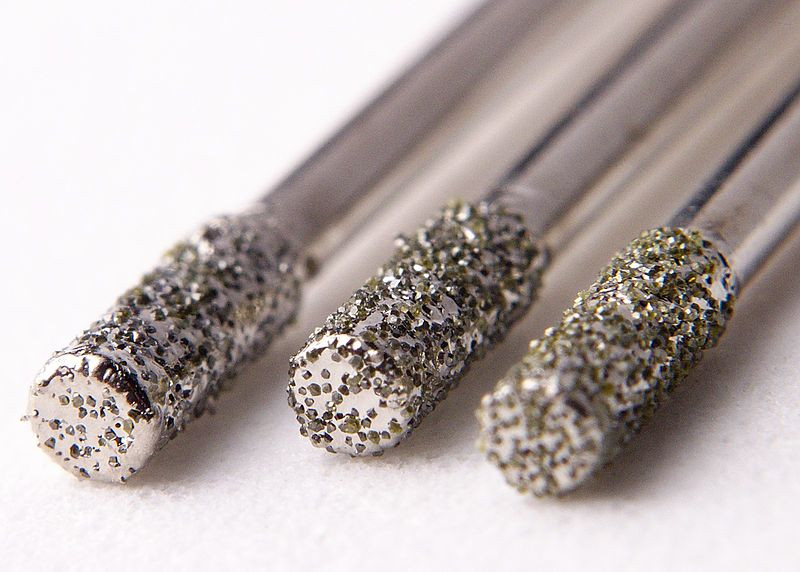 Pictured above: Diamond coated 2mm bits, used for drilling materials such as glass | Image credit: Junkyardsparkle, Public domain
Pictured above: Diamond coated 2mm bits, used for drilling materials such as glass | Image credit: Junkyardsparkle, Public domain
Beyond Beauty: Diamonds' Industrial and Scientific Value
Did you know most diamonds are not used for jewelry? As of 2019, roughly 80 percent (by weight) of diamonds worldwide are used in research or industrial applications.
Industrial diamonds can be synthetic or natural. Natural ones are not gem-quality, like the small, dark, and opaque bort. However, synthetic diamonds are often preferred, since they can be customized, duplicated indefinitely, and created with less environmental impact.
Industrial Applications of Diamonds
Some of diamond’s valuable industrial qualities are its hardness, high thermal conductivity, broad optical transmission, and resistance to radiation.
Primarily, industrial diamonds are used as abrasives for grinding, cutting, drilling, and polishing other materials. Diamond windows are used in lasers, spectroscopy equipment, and infrared imaging.
Diamonds are also used in medicine and various technology components. In devices like computers, diamonds help dissipate heat and serve as semiconductors.
Diamonds in Scientific Research and Exploration
The technology and engineering industries have made great strides with diamond applications.
One popular device is the diamond anvil cell (DAC), which helps scientists recreate extreme pressure conditions.
Other experimental uses for diamonds include:
Radiation detection
Acoustics (e.g. tweeter dome speakers)
Treating wastewater contamination
Studying brain chemistry (e.g. diamond-coated microelectrodes)
Creating quantum computer bits (qubits) in nitrogen-vacancy (NV) diamond centers
MIT researchers in 2020 even started experimenting with changing diamonds’ electrical conductivity without altering the stone’s stability or composition, opening the potential for custom-designing diamonds for different functions.
Cleaning and Caring for your April Birthstone
The best way to clean your April birthstone is to use a mild detergent, soft brush, warm water and lint-free cloths.
Apply detergent, use a soft toothbrush to gently brush your birthstone, and then rinse it under warm water. After you’re done, make sure you dry it with a soft towel. Don’t leave it out to air dry, as this will create spots, similar to water spots that you find on glass.
We also recommend that you take your diamonds to a jeweler every few months, as they will be able to ensure that your April Birthstone is in great condition.
On a more serious note, you may wonder about the conditions of diamond mining and how ethical they are.
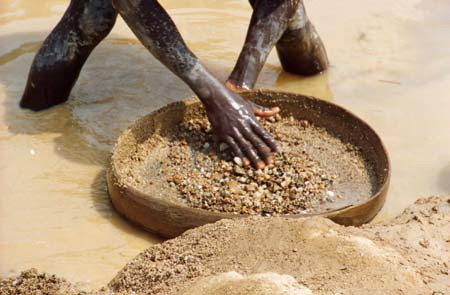 Pictured above: A miner in Kono District, Sierra Leone searches his pan for diamonds | Image credit: USAID Guinea, Public domain
Pictured above: A miner in Kono District, Sierra Leone searches his pan for diamonds | Image credit: USAID Guinea, Public domain
The Ethical Diamond Dilemma
More conscious consumers today try to avoid “conflict diamonds,” or “blood diamonds,” meaning diamonds mined and sold to finance armed conflicts against governments. Humanitarian issues like forced labor, child soldiers, and loss of life are tied to these diamonds.
Efforts to combat this include the Kimberley Process, a coalition established by the United Nations in 2003 to provide more oversight and transparency on where diamonds come from. Participants in the coalition must meet ethical sourcing criteria for their diamonds to be considered “conflict-free” with a Kimberley Process Certification.
However, even “conflict-free” diamond mining still has major negative impacts on the environment and nearby communities.
This consideration has led many to synthetic (lab-grown) diamonds.
Synthetic diamonds are manufactured but have all the chemical and physical properties of natural diamonds, minus the impurities. They’re created for both industrial and gemstone uses.
Although energy emission is still a negative impact with synthetic diamond manufacturing, these emissions are still 5.5-times lower than the emissions of the most eco-conscious diamond mines, according to a 2020 Stanford comparison.
Still, the negative feelings toward diamonds may have you wondering: is diamond the only birthstone for April? Nope!
4 Alternative April Birthstones
Like non-diamond engagement rings, April birthstone rings and jewelry can also feature other gems.
There are many diamond alternatives, from moissanite to white sapphire. But what are the other April birthstones? The alternative April birthstones are:
Sapphire
Opal
White Topaz
Quartz
Below, we’ll look at the properties and meanings of these gems, some of which were considered April birthstones long before diamonds.
Sapphire
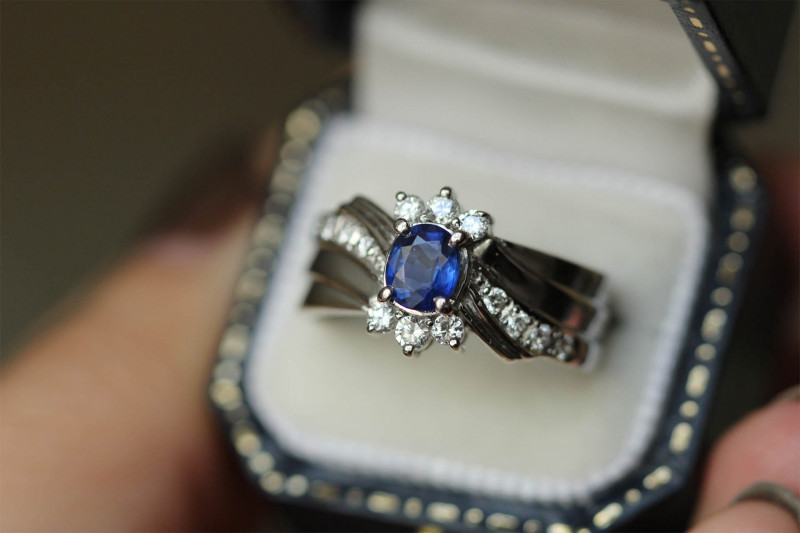
Did you know diamond wasn’t the original April birthstone? The first historical birthstone lists, derived from Biblical lists of 12 stones, listed April’s birthstone as sapphire.
In fact, Ancient Romans, Italians, Russians, Hebrews and even Arabic cultures considered sapphire to be the April Birthstone, despite the idea of sapphire as a September birthstone today.
Sapphire is thought to bring inner peace and relieves mental tension for those who wear it. Additionally, it helps with depression and promotes self-expression.
Opal
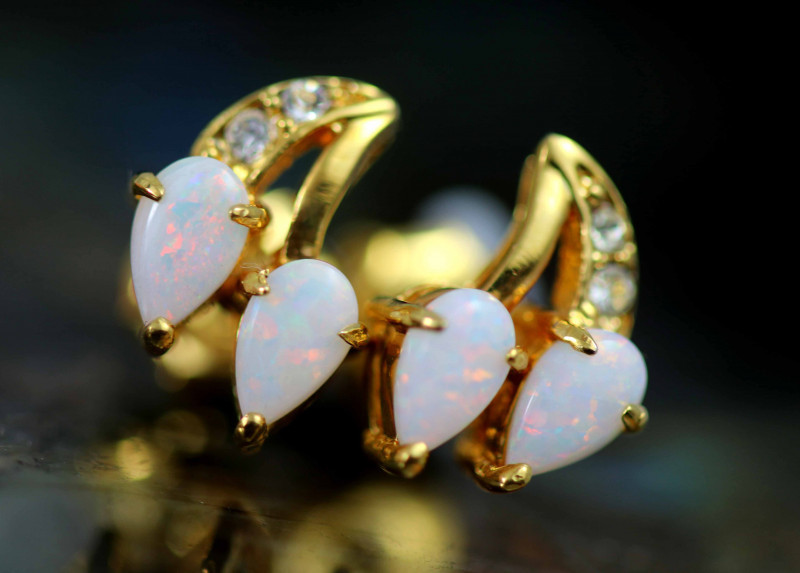
The mystical birthstone lists, rooted in ancient Tibetan astrology, list opal as the April birthstone.
Besides Tibetans, ancient Greeks were also known to consider opal the April birthstone. Back then, opals were believed to give the power of foresight to those who bear it.
Today though, opals are thought to absorb and amplify the thoughts, feelings, and characteristics of those who bear them, and to help bring them to the surface.
White Topaz
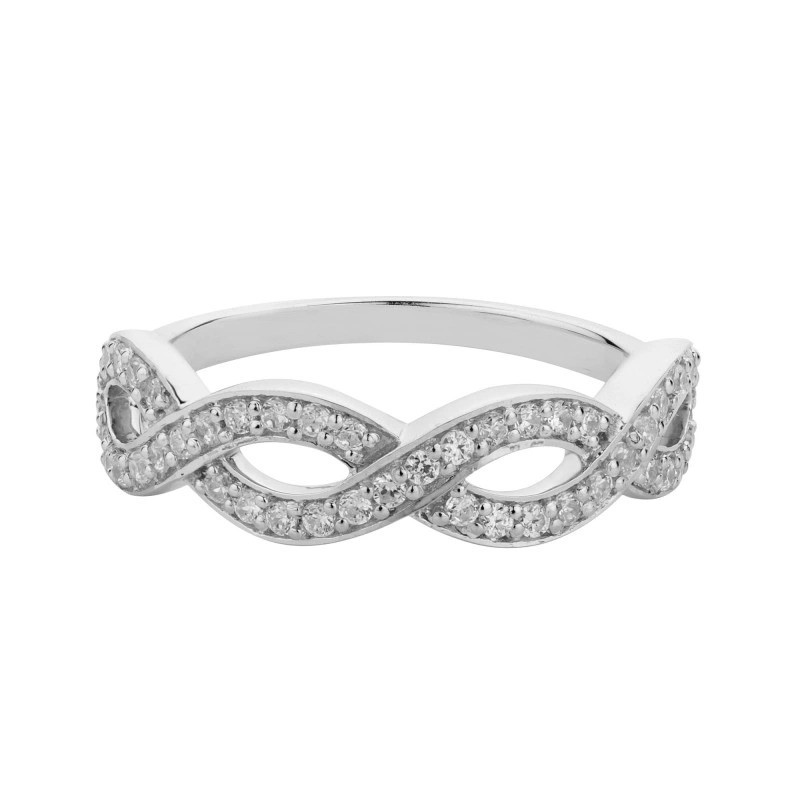
A modern alternative April birthstone often listed is white topaz, a popular diamond alternative. (You can see their comparison in our white topaz vs diamond guide.)
It is believed that those who possess white topaz will be more conscious of their own thoughts and actions. White topaz is also thought to release stagnant energy, helping the wearer move forward with their life.
Quartz
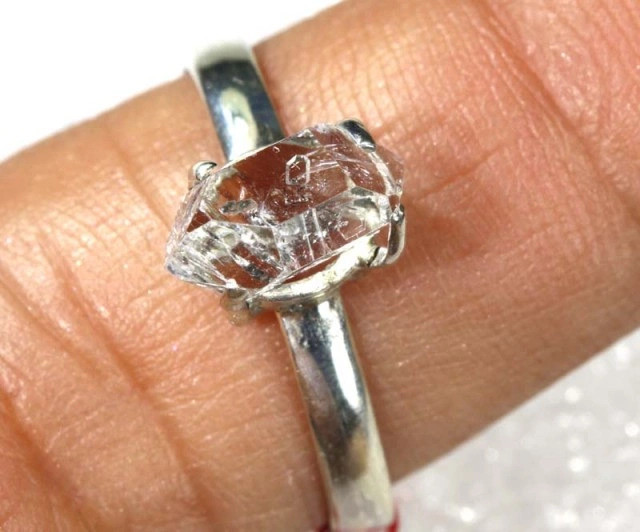
In Britain, quartz is often referred to as the birthstone for April. The stone is thought to be a stone for clarity, and often a source of inspiration and creativity. Quartz stones can also help with improving your concentration and retaining knowledge.
Pearl
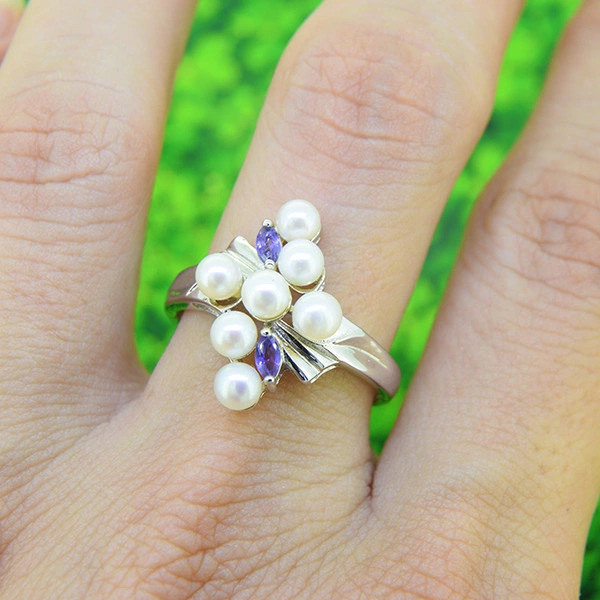
Is pearl an April birthstone? It can be! Just as some consider pearls precious gems like diamonds, the stones are also sometimes considered equal April birthstones.
Though traditionally a June birthstone, pearls reflect the symbolism of love, integrity, and commitment associated with diamonds and April.
Personalized April Birthstone Gifts
For a loved one born in April, an April birthstone makes a thoughtful, personalized gift. Don’t forget: diamonds aren’t exclusively for women! These timeless stones have the brilliance and symbolism to suit anyone.
Some options for April birthstone gifts:
Colorless diamond ring
Diamond-studded cufflinks
Diamond-encrusted whiskey decanter
Three-stone diamond necklace pendant (representing parents and a child or three close friends)
Colorless loose diamonds to custom-make into a truly unique jewelry item
Tennis bracelet with diamond April birthstones
Statement colored diamond ring
Diamond earrings
Diamond-studded watch
Thought diamonds were one-note? Think again! The April birthstone offers limitless variety.
Before you gift diamond jewelry to someone special, be sure to note their favorite colors or browse their Pinterest for inspiration.
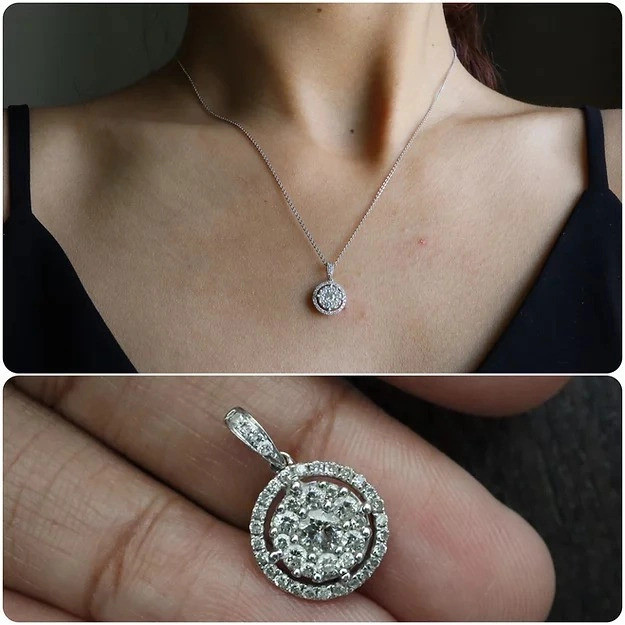
Enjoy April Showers of Diamonds with this Timeless Birthstone!
That concludes our April birthstone article! To learn more about the traditional April birthstone, read our full guide on diamonds here.
Ready to show an April birthday how much you care? Shower them with the eternal love that shines from the heart of a beautiful diamond birthstone.
Find traditional and alternative April birthstones from our hundreds of gemstones available!
Was this article helpful?
8 people found this article helpfulRoss Sedawie
- Written - 26th Mar 2016
- Edited - 17th Mar 2024


















